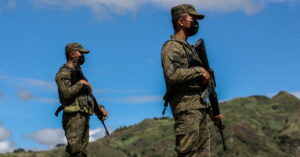Naiveté is doing the same thing repeatedly and expecting the same result.
THE great physicist Albert Einstein defined insanity as doing the same thing over and over and expecting different results. Einstein’s timeless wisdom is embedded in a profound truth applicable to the enduring dispute at Ayungin, or Second Thomas Shoal, between the Philippines and China over the past two decades. It becomes painfully evident how the protracted standoff at Ayungin Shoal encapsulates the essence of repeating futile actions while anticipating divergent results, highlighting the urgent need for a different approach.
This situation is a stark reminder of the pitfalls of entrenched positions in navigating intricate diplomatic challenges. It also reveals certain naiveté in navigating complex geopolitical tensions, devoid of adaptation or innovative out-of-the-box strategies in resolving the standoff in the Ayungin Shoal and the broader dispute over the contested waters of the South China Sea (SCS).
Perplexing stance
The Philippines’ expectation of a different response from China regarding the dispatch of construction materials to refurbish the Sierra Madre Navy ship at Ayungin Shoal is quite perplexing. It appears to overlook the historical context and China’s consistent stance. China has firmly opposed efforts to fortify or refurbish the Sierra Madre. Since 1999, China has consistently opposed reinforcing, repairing, or augmenting troops and infrastructure on the Sierra Madre, viewing such actions unfavorably. However, humanitarian supply for Filipino troops stationed there has been fine for the Chinese authorities. Indeed, it’s a matter of common understanding among regional countries and insightful Filipinos that the continuous provision of humanitarian aid to the Philippine troops stationed on the deteriorating Sierra Madre vessel has persisted for over 24 years since May 9, 1999, despite occasional challenges. Reflecting on this, it appears evident that if China had indeed intended to disrupt these crucial supplies, our troops aboard the aging Navy ship would have endured for a shorter duration.
Looking at the Ayungin Shoal or Second Thomas Shoal situation, it’s apparent from my perspective that China will deploy extensive efforts and strategies to uphold the area’s current state, aligning with its claim. This mirrors the Philippine efforts to assert that the Ayungin Shoal falls within its exclusive economic zone (EEZ). This “tug-of-war,” if not mitigated, will possibly lead to some unfortunate scenarios and complicate the situation of the contested waters of the SCS extremely. This prompts a straightforward inquiry: Is it truly beyond the comprehension of the Marcos administration to recognize all these without delving into complexities reminiscent of rocket science?
Furthermore, it remains perplexing for the Philippines to continue with its megaphone diplomacy strategy whenever tensions flare around the Ayungin Shoal or other disputed areas in the South China Sea, amplifying the issue and portraying China as a bully. This tactic has yielded little progress or results over the past two decades. It’s as if, by employing these methods, the SCS dispute will miraculously resolve itself, or China will suddenly capitulate. Such notions seem far-fetched and can be likened to “political gaslighting,” where partial truths and conjectures are manipulated to shape a narrative aimed at influencing and controlling public perception or causing confusion among the Filipino populace. This serves to stoke anti-China sentiment and anxiety yet offers little pragmatic value in terms of resolving the SCS dispute. One cannot help but question the intention behind all these by the Marcos administration. Is it perhaps to justify the ongoing militarization of the Philippines?
Militarization
The ongoing militarization of the Philippines through various defense agreements and military arrangements, including the Enhanced Defense Cooperation Agreement (EDCA), Visiting Forces Agreement (VFA), and the Mutual Defense Treaty (MDT) between the Philippines and the United States, and potentially others like the Reciprocal Access Agreement (RAA) between the Philippines and Japan, reflects a significant shift in the country’s strategic posture and its implications for sovereignty and regional security. This militarization is often viewed within the broader context of the United States’ strategic pivot to Asia, ostensibly aimed at countering and containing China and ensuring the so-called freedom of navigation in the contested SCS, which, as far as the Americans are concerned, is not really about the free passage of commercial ships but is all about the free passage of US warships devoid of limits and reprimands from regional countries.
The ongoing militarization of the Philippines no doubt has implications for Philippine sovereignty.
It raises valid concerns about the extent of control the Philippines retains over its territory and the implications for its sovereignty. The Philippines’ strategic location makes it a pivotal player in any potential military conflict in the Asia-Pacific region, particularly in the context of rising geopolitical tensions between the US and China. The militarization through these agreements positions the Philippines as a forward staging ground for the US, enhancing its ability to project power in the region.
Entanglements
Speculations about a “planned war” by the United States against China underscore the high stakes involved in the military buildup in the Asia-Pacific region. Hence, through agreements like EDCA and the VFA, RAA and the trilateral pact between the Philippines, the US and Japan, and other defense pacts with the Anglo-Saxon countries like the UK and Australia crafted and pushed under the current Marcos administration, the Philippines finds itself at the intersection of these great power dynamics.
The strategic calculus for the Philippines becomes all the more complex. Aligning closely with the United States offers security benefits but also involves risks, particularly if tensions escalate into conflict. The challenge for the Philippines is to navigate these waters carefully and avoid becoming overly entangled in the strategic rivalries of superpowers.
No doubt, the militarization of the Philippines through agreements like EDCA and the VFA, and potentially RAAs, has profound implications for the country’s sovereignty and its role in the broader geopolitical landscape of the Asia-Pacific region. As tensions between the US and China continue to simmer, the Philippines must carefully balance its strategic interests with its sovereignty concerns, ensuring that its alliances strengthen rather than diminish its position on the international stage.
At the heart of our nation’s challenges lies our tendency to harbor unrealistic expectations from the US, coupled with a lingering colonial mindset. Similarly, the current administration’s unrealistic and impractical assessment of potential full-scale military support from the US, as well as the unwavering determination of the People’s Republic of China and its citizens to defend their territorial and sovereign claims in the SCS, demands careful consideration from the Marcos Jr.’s administration before it’s too late.
However, one undeniable truth remains: Achieving a peaceful, pragmatic and diplomatic resolution to the SCS dispute through open-minded, respectful and sincere dialogue and negotiations, no matter the challenges, is imperative and the most viable way forward in resolving the conflict in the SCS.
Relying on the US’s unreliable promises to confront or combat China in the disputed waters of the SCS will inevitably backfire, proving counterproductive and perilous for the Philippines. Such a stance would only exacerbate the complexity and tension within the contested waters of the SCS.
Thus, it is imperative for all regional nations, including the Philippines, to prioritize the preservation of peace and stability in the South China Sea. Sustaining peace, stability and security within the Association of Southeast Asian Nations and the broader Asia-Pacific region necessitates active involvement from Filipinos and Asians in mitigating the adverse repercussions of geopolitics, including wars and conflicts. In the realm of war, there are no victors, only casualties.
Upon reflection, the intricacies of geopolitics exact a considerable toll, one that the Philippines cannot afford. However, pursuing economic development holds promise for the nation and its people. Prioritizing the path to peace fosters security and stability, ultimately paving the way for economic prosperity through tranquility and cooperation.
Source: The Manila Times
https://www.manilatimes.net/2024/03/30/opinion/columns/is-the-scs-dispute-the-fortifying-justification-for-the-ongoing-militarization-of-the-philippines/1939052


